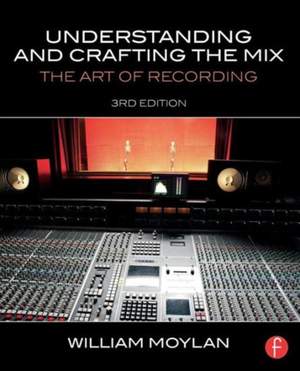Book
$61.75Out of Stock
Contents
- List of Figures
- List of Exercises to Develop Listening, Evaluation and Production Skills
- Foreword by Rupert Neve
- Preface
- Acknowledgements
- Introduction
- Overview of Organization and Materials
- Establishing an Accurate Playback of Recordings
- Part One.
- Defining the Art of Recording: The Sound Characteristics and the Aesthetic Qualities of Audio Recordings
- Chapter 1. The Elements of Sound and Audio Recording
- The States of Sound
- Physical Dimensions of Sound
- Perceived Parameters of Sound
- Summary
- Chapter 2. The Aesthetic and Artistic Elements of Sound in Audio Recordings
- The States of Sound and the Aesthetic/Artistic Elements
- Pitch Levels and Relationships
- Dynamic Levels and Relationships
- Rhythmic Patterns and Rates of Activities
- Sound Sources and Sound Quality
- Spatial Properties: Stereo and Surround
- Conclusion
- Chapter 3. The Musical Message and the Listener
- The Musical Message
- Musical Form and Structure
- Musical Materials
- The Relationships of Artistic Elements and Musical Materials
- Equivalence and the Expression of Musical Ideas
- Text as Song Lyrics
- The Listener
- Conclusion
- Part Two.
- Learning to Listen, Beginning to Hear: Acquiring Fundamental Listening Skills and Establishing an Effective Approach to Listening
- Chapter 4. Listening and Evaluating Sound for the Aspiring Audio Professional
- Why Audio Professionals Need to Evaluate Sound
- Talking About Sound
- The Listening Process
- Personal Development for Listening and Sound Evaluation
- Summary
- Chapter 5. Fundamental Listening Skills
- Introduction
- Background Knowledge and Preparation
- Self Discovery and Realization: "What is Sound to You?"
- Beginning to Hear the Relationships and Qualities of the Mix
- Hearing Subtle Qualities
- Conclusion
- Exercises
- Chapter 6. A System for Evaluating Sound
- System Overview
- Sound Evaluation Sequence
- Graphing the States and Activity of Sound Components
- Plotting Sources Against a Time Line
- Summary
- Exercises
- Part Three.
- Understanding the Mix: Developing Listening and Sound Evaluation Skills
- Chapter 7. Evaluating Pitch in Audio and Music Recordings
- Analytical Systems
- Melodic Contour
- Pitch Area and Frequency Band Recognition
- Exercises
- Chapter 8. Evaluating Loudness in Audio and Music Recordings
- Reference Levels and the Hierarchy of Dynamics
- Program Dynamic Contour
- Musical Balance
- Performance Intensity versus Musical Balance
- Exercises
- Chapter 9. Evaluating Sound Quality
- Sound Quality in Critical Listening Contexts
- Sound Quality in Analytical Listening Contexts
- Sound Quality and Perspective
- Evaluating the Characteristics of Sound Quality and Timbre
- Summary
- Exercises
- Chapter 10. Evaluating the Spatial Elements of Two Channel Sound
- Understanding Space as an Artistic Element
- Stereo Sound Location
- Distance Localization
- Environmental Characteristics
- Space Within Space
- Exercises
- Chapter 11. Evaluating the Spatial Elements of Surround Sound
- Format Considerations
- Surround's Sound Stage and the Listener
- Sound Location and Imaging
- Evaluating Location in Surround Sound
- Distance Localization
- Sound Sources and their Environments
- Exercises
- Chapter 12. Complete Evaluations and Understanding Observations
- Pitch Density and Timbral Balance
- The Overall Texture
- Relationships of the Individual Sound Sources and the Overall Texture
- The Complete Evaluation
- Using Graphs for Making Evaluations in Production Work
- Summary
- Exercises
- Part Four.
- Crafting the Mix: Shaping Music and Sound, and Controlling the Recording Process
- Chapter 13. The Roles of the Recordist and the Aesthetics of Recording Production
- The Functional Roles of the Recordist
- The Artistic Roles of the Recordist
- The Recording and Reality: Shaping the Recording Aesthetic
- The Recording Aesthetic in Relation to the Performance Event
- Altered Realities of Music Performance
- Summary
- Chapter 14. The Sounds of Recordings: Shaping Musical Ideas and Musical Expression
- The Artistic Elements of Sound as Musical Materials
- Sound Qualities
- Timbral Balance and the Mix
- Sound Stage
- Environments
- Noises, Distortions and Unwanted Sounds
- Musical Balance
- Chapter 15. Preproduction and Preliminary Stages: Embracing Reality and Defining the Materials of the Project
- Sound Sources as Artistic Resources, and the Choice of Timbres
- Microphones: The Aesthetic Decisions of Capturing Timbres
- Equipment Selection: Application of Inherent Sound Quality
- Monitoring: The Sound Quality of Playback
- Summary
- Exercises
- Chapter 16. Recording and Tracking: Capturing and Shaping the Performance
- Approaching the Recording: Tracking and Recording Sessions
- In Session: Shifting Focus and Perspective
- An Overview of Two Production Sequences
- Editing: Rearranging and Suspending Time
- Signal Processing: Refining Sounds and Music
- Preparing for the Mix
- Exercises
- Chapter 17. Crafting the Mix, and Finalizing the Production
- Mixing to Support the Music and the Text
- The Mix: Composing and Performing the Recording
- Mastering: The Final Artistic Decisions
- The Listener's Alterations to the Recording
- Concluding Remarks
- Exercises
- Glossary
- Bibliography
- Discography
- Index




